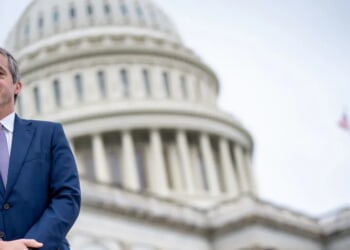In the coming weeks, The American Spectator will be publishing a series of articles from its 2025 Young Writers Program cohort of interns on the role young conservatives can play in today’s shifting cultural zeitgeist. This series is beginning with a case for a pugnacious approach toward historically or culturally significant institutions under the spell of extreme left-wing ideology
As conservatives, we recognize that history and heritage matter. We have been forced to confront the fact that the precious institutions that served as the home of our national culture are today often under siege, if they have not already fallen.
Conservatives have typically taken the approach of fortification, building alternative institutions for conservatives as varied as the University of Austin, Angel Studios, and Parler. These organizations have often done amazing work. They must not, however, be the sole expression of a conservative approach to institutions.
No American cultural or academic bulwark began with Marxism, cultural or otherwise. The Left has demonstrated time and again a willingness to wade into initially hostile environments until they took them over. These takeovers can be permanent, but most are as permanent as the lost conservative control was.
In short, many deeply fallen institutions that maintain cultural or historic prestige can be retaken by a Right willing to work like the Left worked. Left-wing radicals followed the model of the Italian communist Antonio Gramsci when they took over institutions.
In considering how Marxists could take over society, Gramsci essentially arrived at Andrew Breitbart’s dictum that “all politics is downstream of culture.” In his words, “the conquest of cultural power comes before political power.” However, Gramsci recognized how much of culture was the product of significant institutions that shaped public opinion.
The American Right has recognized the importance of culture, but it has instead often used it to justify leaving these significant institutions in pursuit of preserving traditional culture through smaller, newer institutions. However, this only empowers the Gramscian leftist approach. The large institutions that shape the zeitgeist for the millions who consume media or attend universities without consideration of ideology were left entirely in the grasp of Marxists.
The neoconservative intellectual Norman Podhoretz regretfully recalled that “there was no effective counterattack” to the post-1960s takeover of cultural institutions. Podhoretz noted the influence of Gramsci on his revolutionary enemies, as did a conservative coterie from Patrick J. Buchanan to Rush Limbaugh.
Christopher Rufo has pioneered recycling Gramsci on the Right into a blueprint for retaking lost institutions. Rufo’s strategy has repeatedly succeeded, including when he collaborated with Florida Gov. Ron DeSantis to take back Florida’s public university system.
Rufo is now a trustee of the New College of Florida, a public liberal arts college founded as a leftist bastion in the 1960s. He serves alongside other important conservatives, such as Charles R. Kesler, otherwise editor of the Claremont Review of Books and a professor at Claremont McKenna College.
The student communists of the 1960s dubbed their approach the “long march through the institutions.” Conservatives can ask “what would Marxists do?” and instigate our own cultural renewal by turning the rulebooks of radicals back on them.
Colleges are a practical example of this approach winning on the cultural frontline.
A friend of mine once took a supposedly introductory class on Confucius with assigned reading covering the intersection of the philosopher with various Marxist inspired ideologies. Not one page of the actual writings of Confucius made it into the syllabus. Countless similar stories of the extremity of radical intersectional and critical thought on college campuses abound.
This does not come from nowhere. Many institutions abound with Marxism but are not fully lost and maintain strong academic departments free of woke pseudoscience. Other once great institutions are teetering on the brink. Conservative students here play a vital role in dragging them back to sanity.
The Foundation for Individual Rights and Expression (FIRE) maintains an extensive database of college free speech rankings. FIRE tracks incidents of speech suppression and surveys the political and social attitudes of student bodies, including toward speakers they disagree with.
Two hundred thirty-two out of the 254 schools FIRE monitors have predominantly left-of-center student bodies. Institutional strongholds such as Hillsdale College or Thomas Aquinas College do amazing work, but they are not the only options for conservative students. Young conservatives can often make the most difference in places with a politically mixed, if left-leaning student body, and a commitment to open debate.
Institutions with a liberal-leaning student body but vigorous reputation for free speech include Auburn University, Claremont McKenna College, and Florida State University. At these schools, students strongly disagree with shouting down speakers and expressed an openness to hearing ideas they disagree with.
FIRE’s highly ranked schools for free speech all displayed strong levels of political differences, with significant liberal and conservative student populations. The opportunity to have conservative peers to explore your own beliefs is as important as the ability to make friends able to challenge them, experiences that will ultimately strengthen your own ability to defend your convictions.
Putting yourself in a position to challenge the beliefs of others furthers the cause of conservatism in America and the civil discourse at the heart of our republic. In classes or other settings where many of your peers will be ignorant of the conservative response to their views, your voice against woke mythology can make erstwhile opponents understand the Right.
If not making converts, conservative students can at least turn hostility into polite disagreement from the campus Left by popping their ideological bubble and breaking the campus echo chamber. In a recent piece, first published in Yale University’s anonymous journal Publius and later in The Free Press, liberal students open to free dialogue argued that conservatives in overwhelmingly liberal institutions actually benefit most from the education liberal institutions seek to provide.
These Yale students felt that their conservative peers spent their time in college defending their ideology. Their undergraduate education was steeped in a sort of Socratic tutelage as they delved deeper into their beliefs in response to challenges and questions. Meanwhile, the presence of conservatives forced liberal students to do the same instead of relying on empty slogans and the hegemony of woke thought.
Conservative students can work with and through organizations such as College Republicans or Young Americans for Freedom to have a say in how free speech cases are handled, impact the hiring of faculty, and criticize the excesses of DEI or similar programs.
Conservative students at the University of Wisconsin-Madison served as an impetus for the state legislature in its decision to require the university to establish a professorship focusing on the conservative intellectual tradition as part of a wider funding deal.
Many speakers hosted by conservatives draw in liberal audiences. In other colleges, College Republicans groups have successfully cohosted events with their counterparts in College Democrats. Such occasions include an election night watch party at Case Western Reserve University and a series of debates last fall at Vanderbilt University.
Debates or group discussions are particularly useful. They give liberal students exposure to views they disagree with and sell the conservative cause to the curious but ideologically uncommitted. This latter group in particular is unlikely to be found at institutions grounded in conservatism, but can be won over.
Liberal campuses have begun to swing across the nation. Leaders of conservative clubs in universities across the country have reported a surge of growth. The right-wing student clubs at the Ivy League are larger than ever.
A dialogue promotion organization called the Heterodox Academy has dozens of college chapters. It is distinctly nonpartisan and focused on free thought and open dialogue. However, conservative students have taken a particular interest for good reason. Any opportunity for dialogue is an opportunity to strengthen your views and win over peers.
The Trump administration’s efforts to curtail the flow of taxpayer dollars to universities using race-based preferences in admissions or turning a blind eye to radical “anti-colonial” efforts has spurred a rush to the center in institutions that now have a vested interest in protecting ideological diversity and civil dialogue.
The Campus Victory Project grew out of Turning Point USA and works to “take back our universities.” It offers counseling and funding to students running for student government positions and has supported hundreds of successful campaigns. Although it has a definite ideological background, Campus Victory is, contrary to accusations of an“ultra-conservative” agenda, strictly nonpartisan and their events always feature a minority of liberal students.
At the University of Notre Dame, students voted Democrat by a 40-point margin in the 2020 election. The Catholic university had clearly shifted to the left, but conservative students kept attending. No one broke away to form a new conservative alternative to Notre Dame. By 2024, the ratio had flipped dramatically and the cultural bulwark’s student body now swung Republican.
Conservative students in these positions can help save some historic institutions and retake others. The front lines are there and waiting for you, from Carnegie Mellon University to the University of Pittsburgh.
When conservative counterinstitutions achieve greatness, radicals will come for them as surely as they came for the originals. A constant inclination toward defense will never be sufficient.
This should not be taken to an extreme. Elementary schoolers certainly aren’t equipped to be the vanguard of counterrevolution. College students are a different story, we can and have won back institutions at the center of the cultural debate.
The Right cannot win the culture war without going on the offensive. Doing so strengthens our ability to hold our own in a politically divided world while offering the best hope for rescuing once vibrant institutions.
READ MORE from Shiv Parihar:
81 Years Since Heroic Plot to Kill Hitler


![Former Bravo Star Charged After Violent Assault Using a Rock-Filled Sock in Tennessee Walmart [WATCH]](https://www.right2024.com/wp-content/uploads/2025/07/Former-Bravo-Star-Charged-After-Violent-Assault-Using-a-Rock-Filled-350x250.jpg)



![Illegal Alien Walked Free After Decapitating Woman, Abusing Corpse for Weeks [WATCH]](https://www.right2024.com/wp-content/uploads/2025/07/1753013138_Illegal-Alien-Walked-Free-After-Decapitating-Woman-Abusing-Corpse-for-350x250.jpg)
![NYC Man Snatches Child Off The Sidewalk, Parents Chase Him Down [WATCH]](https://www.right2024.com/wp-content/uploads/2025/07/NYC-Man-Snatches-Child-Off-The-Sidewalk-Parents-Chase-Him-350x250.jpg)
![Man Arrested After Screaming at Senators During Big Beautiful Bill Debate [WATCH]](https://www.right2024.com/wp-content/uploads/2025/06/Man-Arrested-After-Screaming-at-Senators-During-Big-Beautiful-Bill-350x250.jpg)
![Leftists Lose Their Minds After Jason Kelce Celebrates Being an American [WATCH]](https://www.right2024.com/wp-content/uploads/2025/07/Leftists-Lose-Their-Minds-After-Jason-Kelce-Celebrates-Being-an-350x250.jpg)





